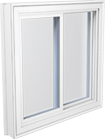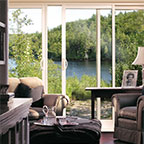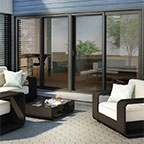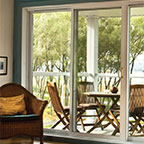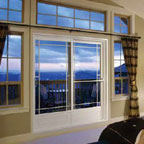Better planning for better results
Up to 25% of heat loss in a home is caused by windows and patio doors, which is why it's important to choose well! The selection of a window’s shape and characteristics – while keeping energy and aesthetics in mind – is very important and remains an uncontested plus in the value of your house.
Take advantage of our tools to guide you in selecting the window type best suited to your needs:
-
Interactive Guide: Choosing Your Windows in 5 Steps
How to choose your Concerto windows from all the available choices? Follow our interactive guide in 5 easy steps. -
The Planner
Discover the advantages and specifics of the different types of windows.
Several signs of wear let you know when it's time to change your windows. Some of the most obvious signs are difficulty opening or closing windows, drafts, excessive condensation or water leaks. Also, rot around a window frame often indicates that it's time to replace your windows.
As a general rule, windows older than 15 years old must be replaced. It's a worthwhile investment, considering the energy savings you'll make through new, more energy-efficient windows.
Casement and Awning Window Systems
Casement and awning windows open outwards using a crank. The casement window is vertical while the awning window is horizontal.
With their extremely robust multi-chamber profiles for superior rigidity and energy performance, our modular casement and awning window series feature unique characteristics to make them the perfect window!
Sliding window systems
Sliding windows have two openings sliding side to side.
The single and double sliding windows series are perfect for tight spaces. They are also known for their excellent value for the money. Narrow profiles allow maximum daylight access and provide unencumbered visibility outside.
Hung window systems
The guillotine window model is among the most popular. Sash windows open by raising the lower half or lowering the top half and can be equipped with one or two movable frames.
The Single and Double Hung Window System is specially designed for high quality remodeling and new construction projects.
Tilt & Turn window systems
Tilt-and-turn windows are powerful multi-function windows. The top of the flap swings inward to allow excellent ventilation while ensuring complete safety when in the open position.
The “La Marquise” Tilt and Turn product line has been developed for the North American residential, commercial and institutional market and designed with a touch of European style.
Consult our guide The Planner to discover the advantages and specifics of different types of windows.
We are proud to offer window models that meet the requirements set by the National Building Code (NBC) for bedroom evacuation.
In order for windows to be an adequate means of escape, the NBC requires a minimum clear opening area and that the windows can be opened from the inside without tools or special knowledge.
Contact us, we will tell you which window models comply with the Code for Room Exit Outlets.
PVC means polyvinyl chloride. This plastic is the most popular material for windows. PVC windows are the most economical and are known for their energy efficiency
The hybrid window offers the best value for the price. It combines the strength and durability of an aluminum exterior finish with the energy efficiency and easy maintenance of interior PVC.
The main advantages of multiple glazing are that a very thin metallic coating (Low-E) is usually applied to one surface of the glass which reduces heat transfer through the glazing and that the spaces between the panes can be filled with argon gas to increase the efficiency of the glazing by reducing air flow between the panes. In summary, these types of glazing are very effective in insulating your home and reducing energy loss.
In Canada, all homes should have at least double glazing. In some regions, it may be more advantageous to opt for triple glazing to further reduce heat loss, condensation, noise and increase security. However, triple glazing is more expensive than double glazing, so the choice between the two will depend on your specific needs and budget.
Double glazing with Low-E and argon gas consists of two panes separated by a thin layer of air and filled with argon gas. Low-E (Low emissivity) is a very thin metallic coating applied to one surface of the glass that reduces heat transfer through the glass. Thus, the use of Low-E in glazing will reduce heat loss in winter and maintain a comfortable temperature inside the home. Low-E is usually applied to the inside of the glazing to maximize its thermal performance. Argon gas is used to increase the efficiency of the glazing by reducing the air flow between the two panes and therefore, minimize heat or cold loss. Argon gas also has good insulating properties, which is why it is frequently used to fill the space between the two panes of glass. In summary, double glazing with Low-E and argon gas consists of two panes of glass with a Low-E coating on the inside of one pane and an air and argon gas space between the two panes. This type of glazing is very effective in insulating your home and reducing energy loss.
The same principle applies to triple glazing.
Argon gas is an inert, odorless and colorless gas. It is used in the manufacture of windows to replace air between glass panes because it is an excellent thermal insulator.
The energy-efficient window is an essential part of quality homes. Among other things, it makes it possible to significantly reduce heating and cooling costs while ensuring effective control of indoor heating to increase residents' comfort.
ENERGY STAR® qualified Concerto windows are a sustainable and energy-efficient choice. They allow you to save on heating while helping to maintain the comfort of your home throughout the year.
These performance ratings indicate the performance of doors and windows in the following tests:
A = Air tightness (levels A1 to A3)
B = Water resistance (levels B1 to B7)
C = Wind resistance (levels C1 to C5).
All windows sold in Canada must be rated for these three key performance standards. All of these tests must be conducted in an accredited testing laboratory and are essential to obtain an acceptance number from the Canadian Construction Materials Centre (CCMC).
See The Planner to learn more about performance standards.
The Energy Rating (ER) number measures the overall energy performance of a window. It is based on various factors, including air tightness and U-value (heat transfer rate). The higher the ER number of a product, the more energy efficient it is. The ER value thus allows you to compare fenestration products in order to choose the most energy-efficient option.
The price of the windows varies according to the model, dimensions and materials that compose them.
PVC and its hybrid model are the most economical materials.
For your custom-made windows, get a price quickly using our online tool!
Our products are made to order, according to your specifications.
An expert Concerto technician will be happy to take the exact measurements of your doors and windows at home. However, if you wish to obtain a rough estimate, we recommend taking the measurement inside the interior frames of your doors and windows, as follows: width X height.



